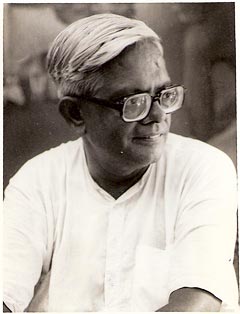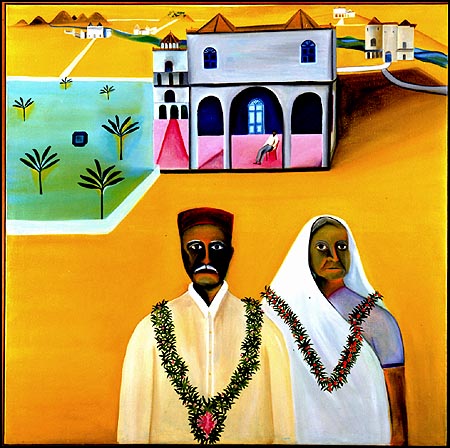An artist must be vulnerable
Leading Indian artist, Bhupen Khakhar, was
born in 1934 in Bombay and his first professional career was as a
chartered accountant. His career as an artist began in his late 30s.
Described in a biography as ´possibly the most provocative painter in
contemporary Indian art´, Khakhar evolved a visual language in his
vibrant panoramic paintings that combined elements of traditional Indian
art with contemporary themes. His open homosexuality was a
controversial contribution to his career as an artist, providing subject
matter and a challenge to galleries and curators, both in India and
elsewhere. Khakhar received international acclaim through many major
solo exhibitions, participation in group exhibitions and work in major
world museum collections.
Bhupen Khakhar,
was born in 1934 in Bombay and his first professional career was as a
chartered accountant. In his 30s he began to feel dissatisfied with
this path and, against the wishes of his family, he went to the School
of Art in Baroda to study art criticism. He started to paint and first
exhibited in India in the mid-1960s. Now regarded as one of India’s
foremost artists, he has been described by Timothy Hyman in his
biography on Khakhar as ´possibly the most provocative painter in
contemporary Indian art´.
Khakhar was invited to teach at Bath Academy of Arts in England for six months in 1979 and this period led to a great affinity with Britain. He met the painters Howard Hodgkin and David Hockney, both of whom have informed and influenced his career. Khakhar received international acclaim long before his artistic strengths were acknowledged in India. Hodgkin helped organise a solo exhibition of his work in Britain at this time.
In the 1980s Khakhar came out as a homosexual and his work, which had started out with a strong pop art flavour depicting incidents from daily life, street market and temple in vivid colour, began to reflect the challenges posed by his sexuality. His early paintings, like Hockney’s work, revolved around the everyday ‘insignificant man’ trapped in an unremarkable existence. He also worked with his contemporaries in Baroda like Gulam Mohammed Sheikh to evolve a visual language that combined traditional Indian art elements with contemporary themes.
Bhupen Khakhar is viewed by many on the Indian cultural scene as ´an iconoclast and a maverick, a man who never did what was expected, and who was open about his views on everything, from sheer sectarianism in society to his homosexuality´ (from Saffronart profile).
After coming out, Khakhar’s work entered what he called his ´gay period´ in which he said, ´I tried to explore and represent the world of homosexuals as I know and understand it.´ His exploration of homoerotic themes is evident in paintings such as ‘You Can’t Please All to Yayati’ and ‘Two Men in Benares’. He was outspoken in his condemnation of social rejection of homosexuality in India where his open gay sexuality and homoerotic themes were viewed as controversial.
Khakhar acknowledged the difficulties this created in his career as an artist since there was a time when no gallery wanted to keep, exhibit or sell his work. Even today, his paintings are excluded from the collections of several galleries. ´The institutions have excluded my work not because they are scared of criticism, but because my work speaks volumes of the absence of any identifiable career in society. Society’s failure to provide such a culture is the theme of my paintings.´ Some of the work is very explicit – homosexual acts depicted in the most gorgeous, rich colours in real and mythological contexts, clearly drawing on India’s Hindu erotic art, and its blatant good humour.
Bhupen Khakhar moved into a more assured and settled period in his later years, working on a series of paintings in Ahmedabad, India’s former industrial mill city known, like Manchester, for its textile history. He lived and worked in Baroda and was touched by the communal violence between Hindus and Muslims in his home state of Gujarat in the early 21st century. He made a number of large works in oils and watercolours commenting on these increased tensions which were exhibited in Manchester in 2002/03 at The Lowry in a major retrospective show organised by the Museo Nacional de Arte Reina Sofia in Madrid.
In his late 60s, Bhupen Khakhar again explored the everyday themes of life in India – Kerala landscapes, roadside cafes in Tamil Nadu, a collage of images of life around a mosque. His work, essentially representative, references Indian miniature paintings, plays with perspective and draws the viewer into spiritual dimensions through a vertiginous saturation of colour.
Bhupen Khakhar was awarded the prestigious Padmashree award by the Government of India in 1984. His work is widely exhibited internationally and included public commissions. It is found in museum collections in India and around the world, from the Museum of Modern Art in New York to the Victoria and Albert and British Museums in London.
SOURCES: Artist’s profile on Saffronart website (www.saffronart.com); review of exhibition at The Lowry in Manchester Online.
Khakhar was invited to teach at Bath Academy of Arts in England for six months in 1979 and this period led to a great affinity with Britain. He met the painters Howard Hodgkin and David Hockney, both of whom have informed and influenced his career. Khakhar received international acclaim long before his artistic strengths were acknowledged in India. Hodgkin helped organise a solo exhibition of his work in Britain at this time.
In the 1980s Khakhar came out as a homosexual and his work, which had started out with a strong pop art flavour depicting incidents from daily life, street market and temple in vivid colour, began to reflect the challenges posed by his sexuality. His early paintings, like Hockney’s work, revolved around the everyday ‘insignificant man’ trapped in an unremarkable existence. He also worked with his contemporaries in Baroda like Gulam Mohammed Sheikh to evolve a visual language that combined traditional Indian art elements with contemporary themes.
Bhupen Khakhar is viewed by many on the Indian cultural scene as ´an iconoclast and a maverick, a man who never did what was expected, and who was open about his views on everything, from sheer sectarianism in society to his homosexuality´ (from Saffronart profile).
After coming out, Khakhar’s work entered what he called his ´gay period´ in which he said, ´I tried to explore and represent the world of homosexuals as I know and understand it.´ His exploration of homoerotic themes is evident in paintings such as ‘You Can’t Please All to Yayati’ and ‘Two Men in Benares’. He was outspoken in his condemnation of social rejection of homosexuality in India where his open gay sexuality and homoerotic themes were viewed as controversial.
Khakhar acknowledged the difficulties this created in his career as an artist since there was a time when no gallery wanted to keep, exhibit or sell his work. Even today, his paintings are excluded from the collections of several galleries. ´The institutions have excluded my work not because they are scared of criticism, but because my work speaks volumes of the absence of any identifiable career in society. Society’s failure to provide such a culture is the theme of my paintings.´ Some of the work is very explicit – homosexual acts depicted in the most gorgeous, rich colours in real and mythological contexts, clearly drawing on India’s Hindu erotic art, and its blatant good humour.
Bhupen Khakhar moved into a more assured and settled period in his later years, working on a series of paintings in Ahmedabad, India’s former industrial mill city known, like Manchester, for its textile history. He lived and worked in Baroda and was touched by the communal violence between Hindus and Muslims in his home state of Gujarat in the early 21st century. He made a number of large works in oils and watercolours commenting on these increased tensions which were exhibited in Manchester in 2002/03 at The Lowry in a major retrospective show organised by the Museo Nacional de Arte Reina Sofia in Madrid.
In his late 60s, Bhupen Khakhar again explored the everyday themes of life in India – Kerala landscapes, roadside cafes in Tamil Nadu, a collage of images of life around a mosque. His work, essentially representative, references Indian miniature paintings, plays with perspective and draws the viewer into spiritual dimensions through a vertiginous saturation of colour.
Bhupen Khakhar was awarded the prestigious Padmashree award by the Government of India in 1984. His work is widely exhibited internationally and included public commissions. It is found in museum collections in India and around the world, from the Museum of Modern Art in New York to the Victoria and Albert and British Museums in London.
SOURCES: Artist’s profile on Saffronart website (www.saffronart.com); review of exhibition at The Lowry in Manchester Online.
Author: Judith Staines



No comments:
Post a Comment